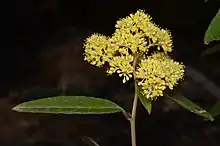| Woolly pomaderris | |
|---|---|
 | |
| Pomaderris lanigera in Expedition National Park | |
| Scientific classification | |
| Kingdom: | Plantae |
| Clade: | Tracheophytes |
| Clade: | Angiosperms |
| Clade: | Eudicots |
| Clade: | Rosids |
| Order: | Rosales |
| Family: | Rhamnaceae |
| Genus: | Pomaderris |
| Species: | P. lanigera |
| Binomial name | |
| Pomaderris lanigera | |
| Synonyms[1] | |
Pomaderris lanigera, commonly known as woolly pomaderris,[2] is a species of flowering plant in the family Rhamnaceae and is endemic to south-eastern continental Australia. It is a shrub or small tree with hairy stems, lance-shaped to egg-shaped or elliptic leaves, and hemispherical clusters of yellow flowers.
Description
Pomaderris lanigera is a shrub that typically grows to a height of 0.5–3 m (1 ft 8 in – 9 ft 10 in), its branchlets covered with shaggy, rust-coloured and star-shaped hairs. The leaves are lance-shaped to egg-shaped or elliptic, 40–130 mm (1.6–5.1 in) long and 20–50 mm (0.79–1.97 in) wide with stipules 4–6 mm (0.16–0.24 in) long at the base but that fall off as the leaf develops. The upper surface of the leaves has a few erect hairs and the lower surface is covered with shaggy, rust-coloured, star-shaped hairs. The flowers are yellow with shaggy rust-coloured hairs on the back and are arranged in more or less hemispherical panicles 40–120 mm (1.6–4.7 in) in diameter. Each flower is on a pedicel 2.5–5.5 mm (0.098–0.217 in) long with bracts at the base but that fall off as the flower opens. The floral cup is 1.0–1.5 mm (0.039–0.059 in) long, the sepals 2–3 mm (0.079–0.118 in) long but fall off as the flowers open, and the petals are spatula-shaped and 1.5–2.5 mm (0.059–0.098 in) long. Flowering occurs from August to October.[2][3][4][5]
Taxonomy
Woolly pomaderris was first formally described in 1809 by Henry Cranke Andrews who gave it the name Ceanothus laniger in The Botanist's Repository for New, and Rare Plants.[6][7] In 1816, John Sims changed the name to Pomaderris lanigera in The Botanical Magazine.[8] The specific epithet (lanigera) means "woolly".[5]
Distribution and habitat
Pomaderris lanigera is widespread in forest on the coast and nearby ranges from south-eastern Queensland through New South Wales to near Melbourne in Victoria.[2][3][4][5]
References
- 1 2 "Pomaderris lanigera". Australian Plant Census. Retrieved 6 March 2022.
- 1 2 3 Harden, Gwen J. "Pomaderris lanigera". Royal Botanic Garden Sydney. Retrieved 6 March 2022.
- 1 2 Walsh, Neville G. "Pomaderris lanigera". Royal Botanic Gardens Victoria. Retrieved 2 March 2022.
- 1 2 Wood, Betty. "Pomaderris lanigera". Lucid Keys. Retrieved 6 March 2022.
- 1 2 3 Robinson, Les (1991). Field guide to the native plants of Sydney. Kenthurst, NSW: Kangaroo Press. p. 204. ISBN 0864171927.
- ↑ "Ceanothus laniger". APNI. Retrieved 6 March 2022.
- ↑ Andrews, Henry Cranke (1809). The Botanist's Repository for New, and Rare Plants. Vol. 9. London: H.C.Andrews. p. 569. Retrieved 6 March 2022.
- ↑ "Pomaderris lanigera". APNI. Retrieved 6 March 2022.
External links
 Media related to Pomaderris lanigera at Wikimedia Commons
Media related to Pomaderris lanigera at Wikimedia Commons